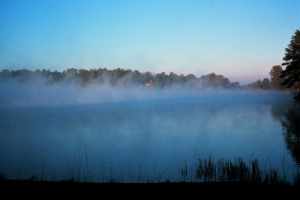 |
 |
| Home | Welcome | What's New | Site Map | Glossary | Weather Doctor Amazon Store | Book Store | Accolades | Email Us |
|
|
 | ||||||||
Weather JournalSteam FogThe Autumn is a grand time for viewing steam fog. Long, clear nights produce substantial surface cooling by dawn and warm, lake, pond and marsh surfaces provide the ideal situation for fog formation. I love to see its tenuous columns rise, like a multitude of small fire smoke plumes. As they slowly rise, they twirl and dance in the light breezes, animating the usually invisible processes of surface convection like a scene from Fantasia (I wonder how I would score the music?).  This Ides of October morning, as I roll across Montana on Amtrak's The Empire Builder from Seattle to Chicago, is no exception. As we pass into the realm of Glacier National Park, a small lake comes into view from which the steam fog rises in wispy towers from its still surface, spiralling and puffing as if the reflected forest was on fire. I had no need to venture outside this observation car to know that the air temperature over the lake is colder than its waters; the lake tells me that. Under clear mid-Autumn skies, this morning's air is likely just above the freezing mark. As a result, the lighter density of the moisture-laden, lake-surface air buoys it upward in tall plumes which become visible because the moist air has been quickly cooled to saturation, much like our breath becomes visible in cold weather. With the calm winds, the rise is nearly vertical, and the long, tendril-like plumes resemble the hanging, swaying arms of inverted jellyfish. Steam fog differs from cold-pool fog in that the surface below is much warmer and more moist in the former case. This allows the formation of random, rising warm air plumes to proliferate over the surface. In contrast, cold pool fogs form when cold, dense air flows like water down terrain slopes, chilling a basin of air to its condensation temperature. In doing so, a fog layer forms which hugs the depression floor like milk in a cereal bowl. If you stop and watch steam fog for any reasonable length of time, you will be attending a weather event fairly common yet usually invisible. The atmospheric condition present is termed by meteorologists as unstable, and perhaps convective if the process extends high enough into the atmosphere. The unstable term stems from the fact that the air near the surface is warmer than that above, and thus is less dense. As a result, the light air is not content to stay at the surface and easily rises once the buoyancy force overcomes the inertia of the warm air parcel. The process can be likened to air bubbles forming on the bottom of a heated kettle as it approaches boiling. The lighter warm air continues to rise until it eventually cools — through mixing or expansion — to become the same density as the surrounding air. Unstable conditions will arise anytime the surface is warmer than the air above — and that includes most sunny days. With steam fog formation, the process becomes visible. By watching the steam plumes rise — from within the field if you have access to a dock or boat — you will witness the twists and turns, rolls and spirals of the plume air. This dance between ephemeral rising plumes and colder surroundings is the ghostly manifestation of the turbulent mixing process. Eventually, the overriding air will again warm above the saturation temperature and the visibility of the rising plumes will cease. That does not mean that the convective process has stopped, however. It will continue invisibly as long as the air at the surface is warmer than the air immediately above it, perhaps later giving its presence away by forming a small cumulus cloud at the top of the plume. Learn More From These Relevant Books
|
|||||||||
 |
To Purchase Notecard, |
Now Available! Order Today! | |
 |
 |
NEW! Now Available in the US! |
The BC Weather Book: |


